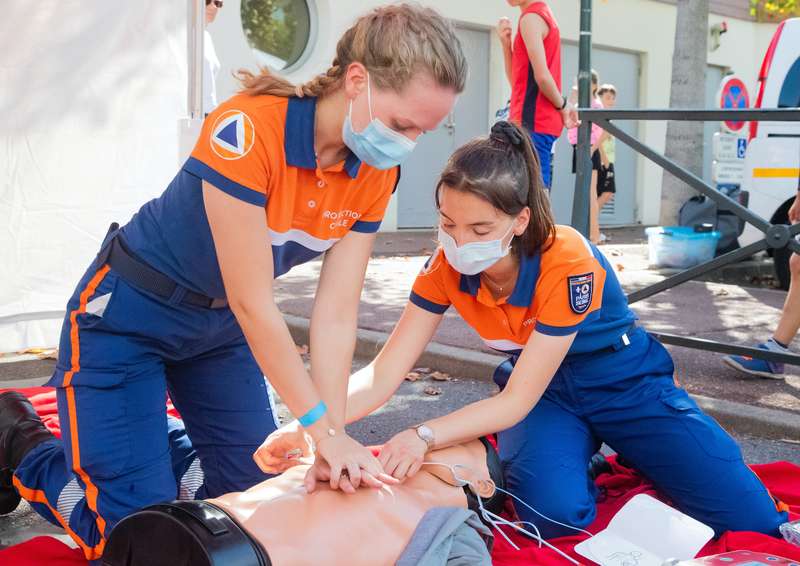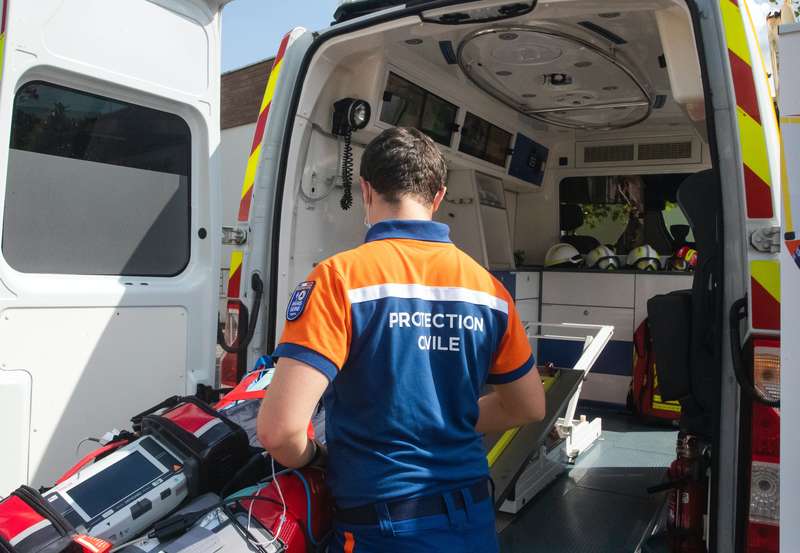If you’re considering becoming an emergency medical technician (EMT), you’ll want to know the requirements and steps you’ll take to get there. Those include the qualifications of an EMT, the training required, the exams you’ll need to pass, and how to acquire licensure.

This simple, straightforward guide will outline those steps so you know exactly what to expect.
The Requirements To Become An EMT
An EMT is a well-trained first responder who assists patients in critically ill or injured conditions. To know how to respond when faced with a wide variety of needs, an EMT is required to take a training program and pass 2 exams before they can become certified to work.
There are various requirements before an individual is ready to take that training program, however, so we’ll discuss each step to make sure you know what comes next.
1. Make Sure You Qualify
First off, you’ll want to make sure you qualify to work as an EMT. This is a list of the general qualifications you’ll want to make sure you can check off before moving forward.
Be 18 years or older
In most cases, you must be a U.S. citizen
You need to be in good health
You must speak english fluently
If you can cross off each of those in the affirmative, you’re good to move on.
2. Get Your High School Diploma or GED
In contrast to being a paramedic, an EMT only needs to have a high school diploma or GED. It is not required to have an associates or bachelors degree. Once you do have that diploma, you’re one step closer to being ready to apply for an EMT training program.
3. Get Your CPR Certification
Next, you’ll want to take an accredited CPR class. These only take about 2-3 hours and can be completed in one evening if you take it in person, or at your own pace if you prefer an online course. Both local healthcare facilities and organizations like the Red Cross offer this class.
4. Get A Physical Exam
Most EMT programs want to know you are physically fit enough to meet the demands of this job. This can be as simple as getting a physical exam by your primary care provider. You may also need proof that you are up to date on all your immunizations and have health insurance.
These are the immunizations you will want to make sure you have.
Immunizations | Required for an EMT |
|---|---|
Hepatitis B | ✓ |
Measles | ✓ |
Mumps | ✓ |
Rubella | ✓ |
Varicella | ✓ |
Tetanus Booster | ✓ |
Pass a Drug Screening | ✓ |
Pass a Tuberculosis Screening | ✓ |
5. Maintain a Valid Driver’s License
Even though a valid driver’s license isn’t always required to take an EMT program, most EMT employers expect you to have one. After you’ve completed all the steps to become a licensed EMT, you can take an additional one or two day class to learn how to drive an ambulance.
6. Submit for a Background Check
While some EMT training programs may not expect a background check before admitting you, you can expect to complete one when applying for state and national licensure. Having a criminal record will not necessarily disqualify you for being an EMT so you’ll want to look into this more.
You may not qualify for certification if you have committed any felonies or misdemeanors involving:
Sexual assault or abuse
Dangerous weapons
Theft
Physical assault
Abuse of children, elderly, or the infirm
7. Take an EMT Training Program
You are finally ready to take an EMT training program. It takes 150 hours, ranging from 6 months to two years, to complete the in-class instruction and the field exposure. You can take this accredited program at a local community college, vocational school, or through an emergency care facility.

Some topics you will learn include:
Medical emergencies
Trauma care
Patient assessment
First aid treatments
8. Pass the NREMT Exams
Upon completing your training program, you will need to pass the National Registry of Emergency Medical Technicians exam (NREMT). This has two parts: a cognitive assessment of your knowledge and a practical assessment of your skills.
NREMT Exam Portions | How it is Administered | What it Assesses | What Happens if You Fail |
|---|---|---|---|
Cognitive Exam | This is a computer adaptive test. It has 70 - 120 questions. It must be completed in 2 hours. | Your knowledge of treating these types of patients:
Your knowledge of these subject areas:
| You can retake the exam 15 days later. You have 6 chances to pass this exam. If you fail 6 times, you must retake the entire EMT training program before retesting. |
Psychomotor Exam | This is given by your training program or the state EMS Office. It is an in person, hands-on practical exam. You will administer treatment to pretend patients in simulated emergency scenarios. | Your ability to perform these types of procedures:
| You have 2 attempts to pass this exam. Within each of those attempts, you may have up to two attempts to pass each scenario. If you fail 2 full exam attempts, you will need to retake the EMT training course before retesting. |
9. Get Your State License
Hooray! You’ve taken your training courses and passed your exams. All that’s left is applying for state licensure. For many states, your NREMT certification is enough to prove your competency. For select states, however, you must provide additional proof before acquiring your license.

You will want to contact your state EMS office to learn what unique licensing steps they have.
Cost For EMT Training
The cost you will have to pay in order to become an EMT depends on your state and specific training program. These charts will give you an estimate of what the different prices might look like.
Type of EMT Training Program | Cost |
|---|---|
University | $800 - $1,000 |
Technical College | $750 - $1,800 |
Community College | $200 - $1,000 |
Additional EMT Certification Costs | Cost |
|---|---|
Books | Up to $200 |
Immunization: Hepatitis B | Up to $50 / dose |
Immunization: TB test | Less than $20 |
CPR Certification Course | Under $100 |
NREMT Exam | $70 |
EMT Recertification | Dependent on each state |
Recertification
You will be expected to renew your EMT certification every 2 years.
Conclusion
This detailed outline has walked you step-by-step through the requirements to become an EMT. If you still have questions, you can check out the EMT training requirements by state.
References
“EMT Training Requirements.” EMT Training Station, 7 Apr. 2016, emttrainingstation.com/emt-training-requirements/#:~:text=EMT%20Training%20General%20Requirements.%201%20EMT%20candidate%20must. Accessed 19 Jan. 2023.
“How to Become an Emergency Medical Technician: EMT Certification & More.” FireScience.org, FireScience.org, 26 Aug. 2019, www.firescience.org/how-to-become-an-emt/.
“How to Become an EMT – Certification and Training Requirements.” Fire Science Degree Schools, 27 Nov. 2018, www.firesciencedegreeschools.com/how-to-become-an-emt-certification-and-training-requirements/#:~:text=To%20obtain%20an%20EMT%20certification%2C%20aspirants%20must%20fulfill. Accessed 19 Jan. 2023.
“Want to Become an EMT? Here’s What You Need to Do.” Trade-Schools.net, 8 Apr. 2020, www.trade-schools.net/articles/become-an-emt.


